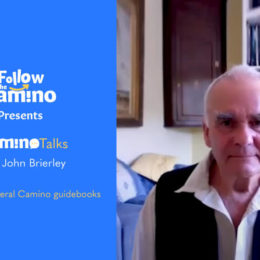Oviedo the beginning of the Camino

Thus the pilgrimage route from Oviedo to Santiago was the original route taken by many pilgrims on the Camino de Santiago.
King Alfonso II promoted Oviedo as the city to pass through for pilgrims on their way to Santiago. To encourage pilgrims to come through Oviedo he built the Cathedral of San Salvador. Here he housed the relics of the Martyrs of Cordoba as well as the Holy Shroud, which is said to have covered Jesus’ face on his descent to his burial.
The importance of Oviedo to the Camino de Santiago can be summed up in the following saying “he who goes to Santiago but not to Salvador, visits the servant but not the Lord”.
Short History of Oviedo
The Kingdom of Asturias began in 720 when Pelagius revolted against the Muslim occupiers of Spain at this time. Oviedo was founded in 762 and has no Visigothic or Roman foundations. Until this point the area was largely uninhabited and so was mostly ignored by the Moorish invaders. In 794 the Moors sacked and pillaged Oviedo but King Alphonse II of Asturias rebuilt the buildings that were destroyed and made it the capital of his kingdom.

In 850 Ordoño I came to power and was the first king to advance southwards into Arab territory. His reign was short-lived and upon his death, his son Alphonse III came to power. During his reign, the Emir Muhammad I, as a diplomatic gift, sent the body of the Cordoban martyr Eulogius to Oviedo, supposedly along with his manuscripts. Alphonse III continued his predecessors building of the city of Oviedo.
Towards the end of his life, Alphonse III was overthrown by his sons and when he died in Zamora his body was returned to Oviedo. It was after this period that the royal court moved to Leon and Oviedo began to lose its importance within the kingdom.
During the 12th Century, Bishop Pelayo de Oviedo, fabricated many Royal Charters. These forgeries were not for his enjoyment but rather to enable him to gain the independence of his see from the archbishop of Toledo or Santiago, as well as promoting Oviedo as a pilgrim destination.
Over the centuries the medieval city of Oviedo grew and at the beginning of the 17th Century an Arts College was founded and increased Oviedo’s urban expansion. The 18th Century seen regional nobility building palaces, the 19th Century then seen industrial expansion and by the 20th Century administrative and commercial development was pushing Oviedo forward.
In the 1930’s Spain was deeply divided between Nationalists and Republicans. Oviedo was directly affected by this unstable period. In 1934 the Asturian miners’ strike resulted in Oviedo being captured by the miners who were armed with dynamite. General Franco sent in the army who overpowered the rebels after heavy fighting and many casualties.
Only 2 years later Oviedo played host to one of the memorable events during the Spanish Civil War, the Siege of Oviedo. This siege lasted for 3 months until the rebels were relieved by the Nationalist forces just as they were making their last stand against the Popular Front.
In 1985 Oviedo was registered as a World Heritage City and today its economy is dependent on Oviedo’s position as the administrative centre of the region. The Camino de Santiago stills brings pilgrims to Oviedo either as a starting point on the Camino Primitivo or the finishing stop for the Camino del Norte.
Oviedo – Things to do
There is no shortage of things to do and places to visit in Oviedo. Thanks to the compact size of its historical centre which has been pedestrianised along with how clean and green the city is, Oviedo is a pleasure to walk around. So whether you are starting, ending or passing through on your Camino journey you will not be disappointed.
Built Heritage
Oviedo has a plethora of churches, palaces and plazas for you to visit and admire. Most importantly for pilgrims is the Cathedral of San Salvador. Originally built in 781 the Cathedral has been enlarged and rebuilt over the centuries to give its present-day form. Within the Cathedral a must-visit for pilgrims is the chapel, Cámara Santa. This chapel houses holy relics such as the Holy Chest, the Cross of Los Ángeles and the Cross of la Victoria.
Mass is held daily in the Cathedral should you wish to attend and you can find out more information on the times of worship on the Cathedral’s website: Cathedral Oviedo – Worship Schedule.
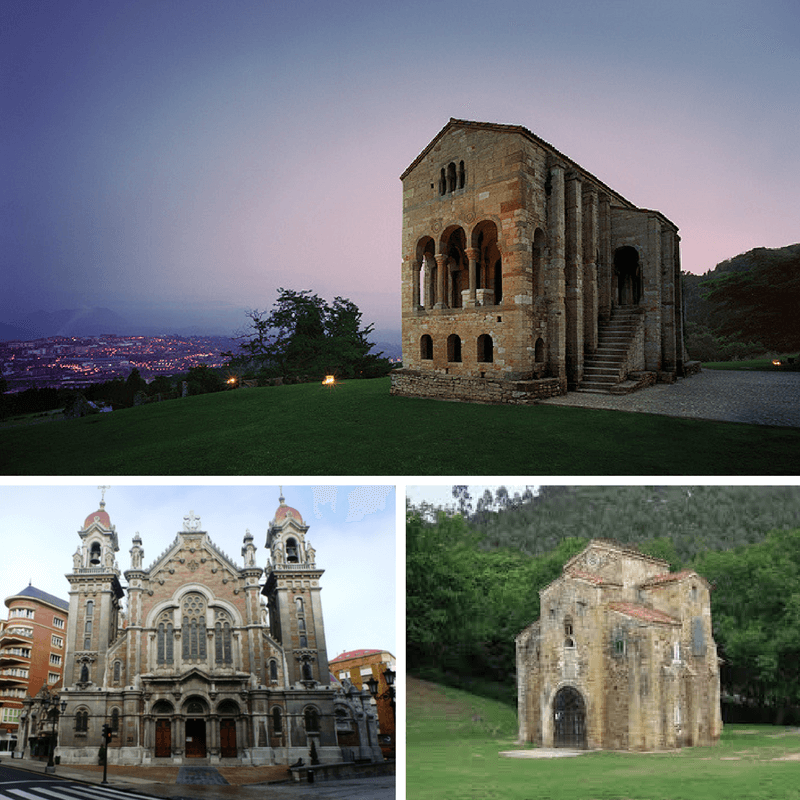
Wandering around Oviedo you will come across many chapels but one visually spectacular church to visit is Iglesia de San Juan el Real. In 1923 General Franco was married at this very chapel. A short 10 minute drive outside of the city centre and a worthwhile visit is the Santa María del Naranco and the nearby San Miguel de Lillo.
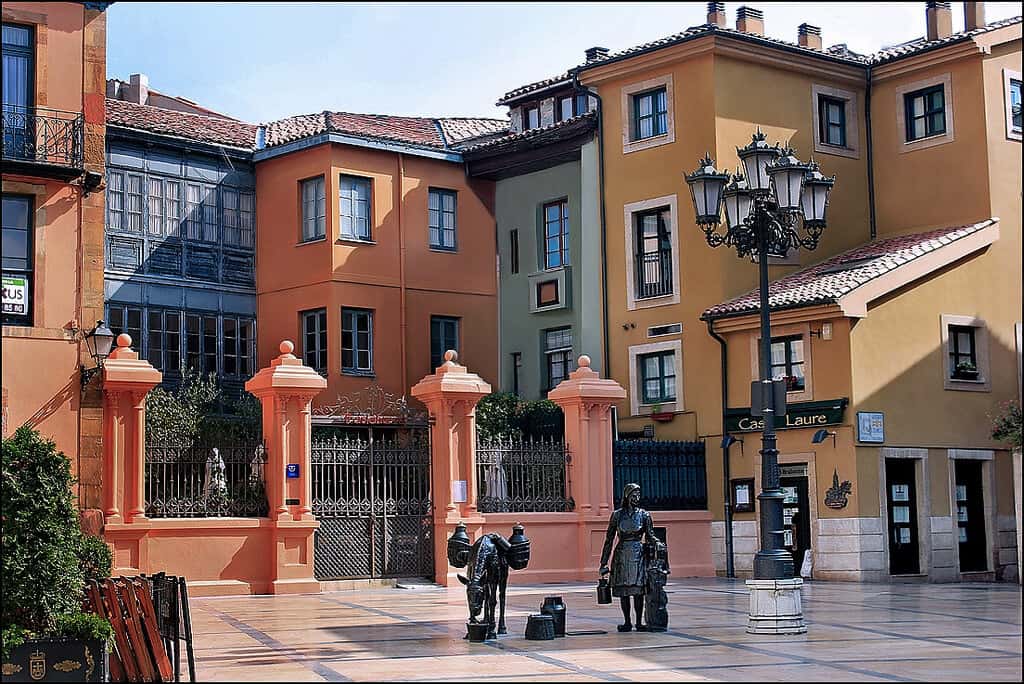
Near the Cathedral is the Fine Art Museum located in the former Velarde Palace as well as the Archaeological Museum located in the former convent of San Vicente.
The Plaza de Trascorrales is a colourful square to visit and where you will see one of the many quirky statues that you will find throughout the city.
To see more of these statues why not take a stroll through the Campo de San Francisco park. Set in what was once the orchard of the Convent you will enjoy strolling through shaded paths discovering monuments and arches as well as potentially spotting one of the peacocks that call this park home.

If you are a film buff or Woody Allen fan then be sure to get your photo with his statue that is just across from the park. If you have watched his film, Vicky Christina Barcelona, you may also recognise some of the places from the movie as it was partly filmed in Oviedo.
As a treat, you might even like to book a stay for your night in Oviedo in the 5* Hotel Reconquista which was in the movie and is also a former hospice from the 18th century.
For a random trivia fact, Woody Allen won the prestigious Prince of Asturias award in 2002 which is hosted in Oviedo.
Oviedo’s most famous athlete is Fernando Alonso, world champion Formula 1 driver. So if F1 is more your speed then why not visit his museum, Fernando Alonso Museum, where you can see not only some of his helmets and overalls but also the cars he has driven and a special focus on his trophy collection.
Explore Oviedo at the end of the Camino Del Norte and treat yourself with a well deserved rest. We can add a few extra nights here for you to relax before you head home.
If you are arriving in Oviedo as the start of your Camino Primitivo, we recommend adding at least one day to acclimatize and get over any jetlag or weariness from your journey.
Get in touch with us to start planning your next adventure on the Camino de Santiago.
Learn more: Download your FREE Camino e-book!
Discover the routes and sections of the famous Camino de Santiago pilgrimage.
DownloadFestivals
Throughout the year there are a number of festivals in Oviedo all with their own charm and allure. In February there is a huge 2 day festival, Antroxu. On the first day of this festival it is an opportunity for children to get dressed up for a costume contest along with street performances and music. The second day then is the turn of adults to partake in a costume contest followed by the further celebrations and fireworks. This festival even has it own menu that is served in most restaurants, Antroxu of Oviedo. This consists of a stew with cabbages, beans, potatoes and sausages. For dessert there is ‘frixuelos‘ which is a crepe filled with cream, chocolate or jam.
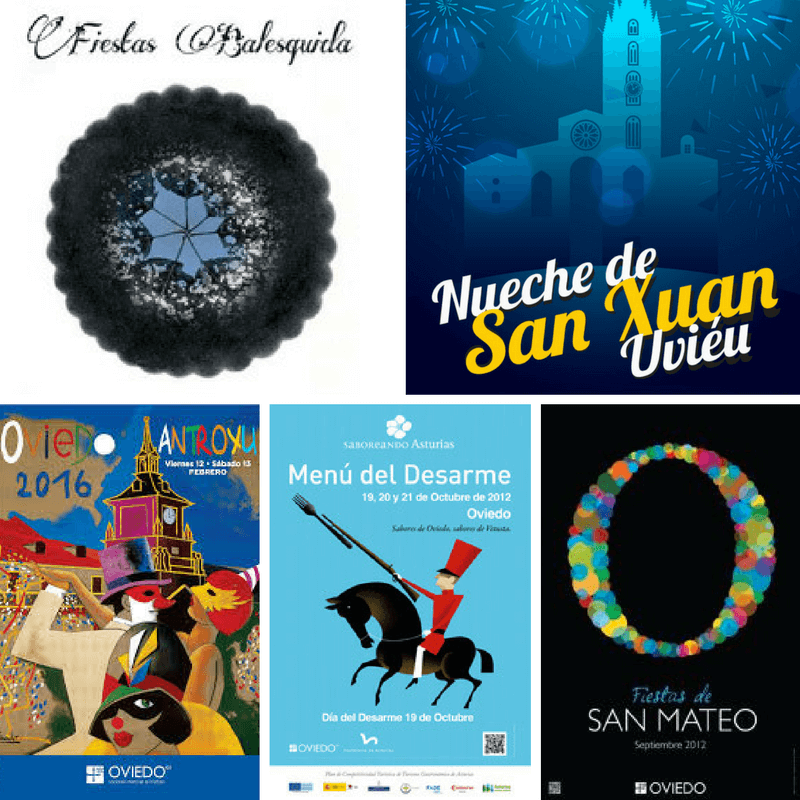
Closely following these celebrations is La Balesquida 0 Martes De Campo, held on the first Tuesday after Pentecost. This celebration dates back to the 13th Century and involves a procession of the Virgin from the church of San Tirso to Capilla de la Balesquida follow by the distribution of ‘bollu preñau‘ (a bread bun stuffed with sausage) along with other food offerings, wine and cider to taste.
In May Oviedo celebrates La Preba on the 22nd. This one day festival is when all the cider houses of the city celebrate the first tasting of the cider for the season. This tasting is free to the public along the street which becomes known as ‘Cider Boulevard’.
On the night of June 23rd Oviedo is La Foguera de San Xuan. On this night bonfires are lit around the city, the largest of which is in Cathedral Square where a traditional Asturian dance is performed around the bonfire.
The largest festival and most important in Oviedo is the Feast of San Mateo, who is the patron saint of the city. This popular week long festival, held the third week in September, includes free performances and concerts as well as a fireworks display. The highlight of the week though is the Parade of Americas which celebrates the many Asturians who left for the new world.
On October 19th, Oviedo commemorates the victory of the locals over the Carlist Army in the 1830s with El Desarme, Disarmaments Day. The special menu for this commemoration consists of cod with chickpeas and spinach, tripe and rice pudding.
Finally then in December they hold the Cabalgata de los Reyes Magos de Oriente. A traditional Twelfth Night parade, where the Three Wise Men of the East parade through the main streets of the city before reaching the Cathedral Square, where they make their offering to the Baby Jesus.
So throughout the year there is plenty of opportunities in Oviedo to enjoy one of its many festivals either at the end of your Camino or when you start.
Gastronomy
Asturias is located between the Bay of Biscay and the mountains of Picos de Europa. Thanks to this location the region boasts both green pastures for grazing and fertile land for growing, as well as on the coast one of the richest fishing areas in the world. Fine food is synonymous with the region and it is known to be the area with the best meat, dairy, vegetables and fish in Spain. A meat dish to try is ‘carne gobernada’ a dish of beet slowly stewed in white wine and vegetables. For fish ‘pixin’ anglerfish is the base for many dishes with it being cooked in cider sauce or added to a bean stew ‘fabada con pixin‘. For dessert there are many options but recommended dishes are ‘Arroz con leche’ a cold rice pudding with milk and cinnamon; ‘frixuelos‘ a crepe like dish filled traditionally with an apple compote or ‘carbayones‘ a traditional dessert of puff pastry stuffed with an almond paste.
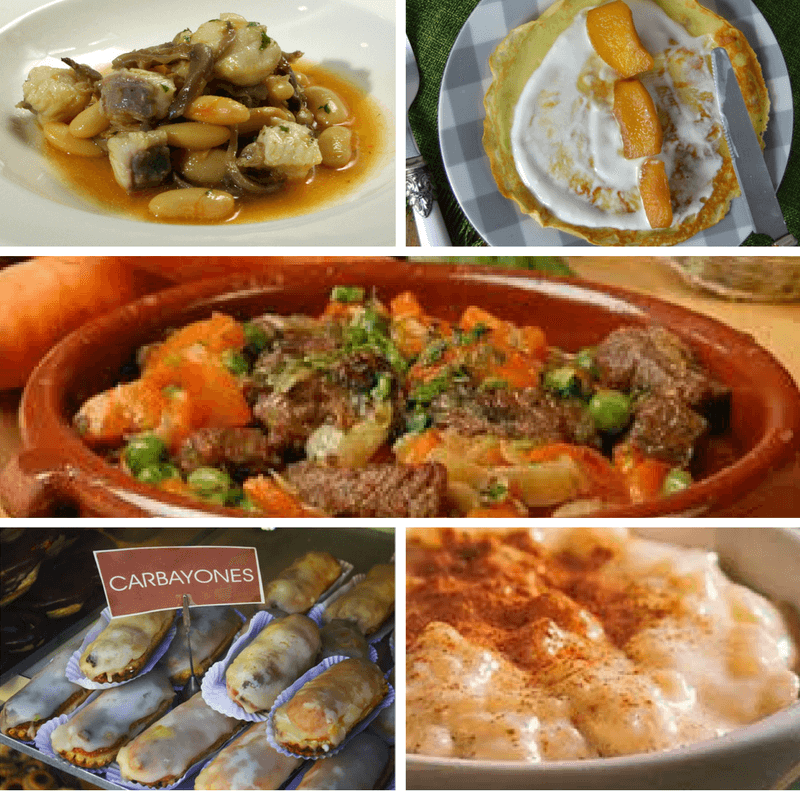
There are two main ‘gastro-routes’ in Oviedo the Wine Route and Gourmet District. The Wine Route is the pedestrianised streets of Campoamor and Manuel Pedregal. These streets are filled with wine bars and throughout the year they have various events happening. The Gourmet District came about as an initiative of a local group of hospitality providers to promote the quality of products, creativity and both traditional and modern cuisine in one district. Throughout the year many events are held and so for any foodie is a must stop when in Oviedo.
Sidra
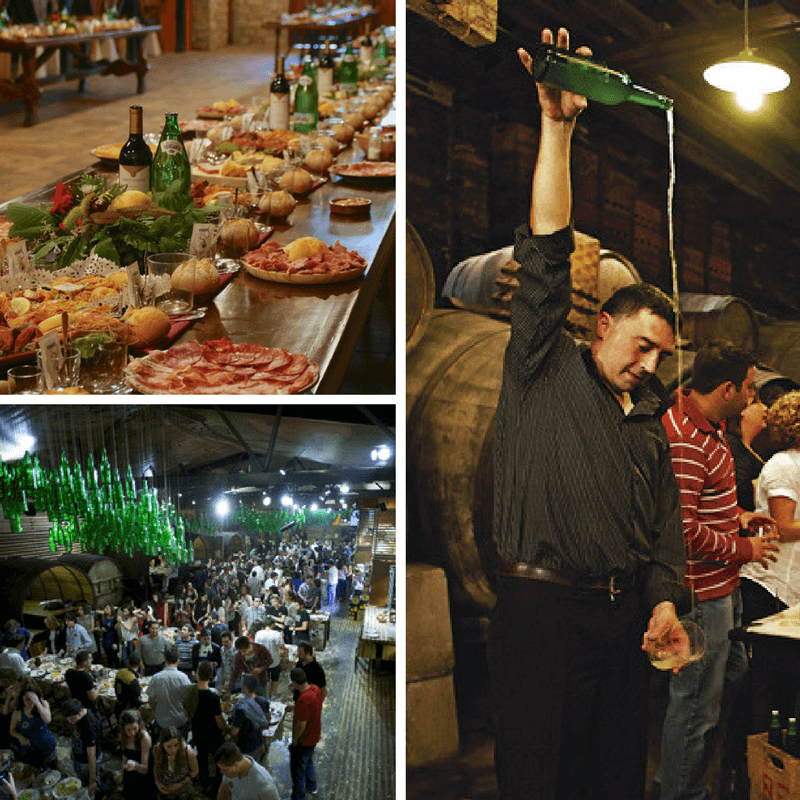
If you are a fan of Cider and have time in Oviedo then you might even like to go one step further and go on a tour of one of the many cider factories in the region or perhaps pop on the train for the short journey to Nava to visit their Cider Museum. When at one of the factories on the outskirts of Oviedo you may be lucky enough to be there when they are having the traditional festive gathering “espicha”. These informal gatherings have a relaxed and fun atmosphere. Watch locals pour the cider from a height into glasses and sample the food that is laid out on large tables in the middle of the room for everyone to enjoy.
Oviedo has much to offer pilgrims on the Camino so if passing through, starting or finishing your Camino here I think you will agree that this is one place you could easily stay for an extra night or two. Why not get in touch to arrange your Camino with a stop in Oviedo by contacting us on info@followthecamino.com.
Learn more
https://en.wikipedia.org/wiki/Oviedo
http://catedraldeoviedo.com/en/
http://www.spain.info/en/que-quieres/ciudades-pueblos/otros-destinos/oviedo.html



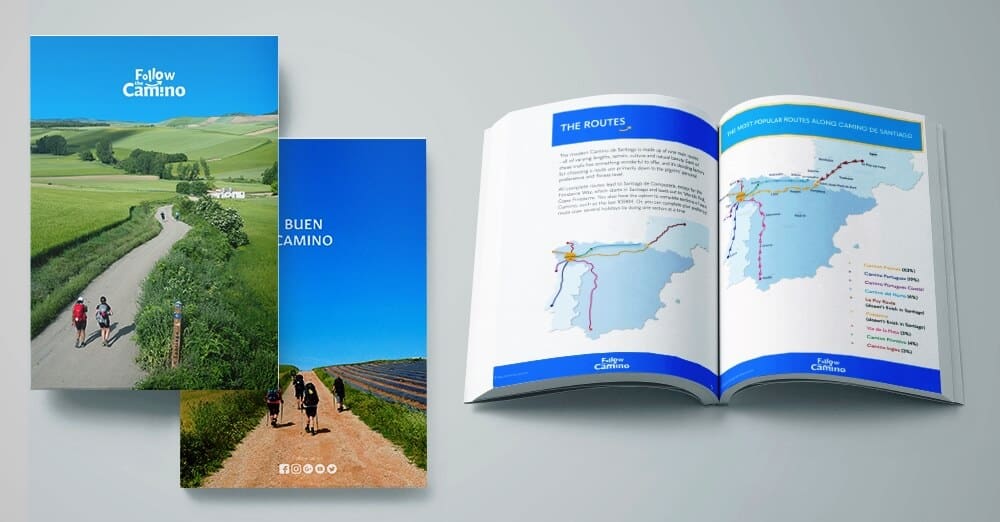

 Flexible itineraries
Flexible itineraries  Luggage transfers
Luggage transfers  Private rooms & bathrooms
Private rooms & bathrooms
